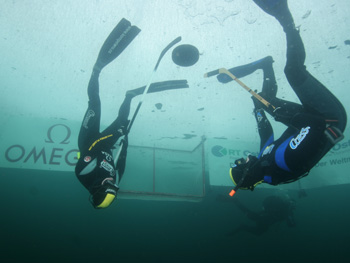 Years ago hockey was played without protective head gear, but then it got to be too rough, so players wore helmets. Later, visors and shields were used to protect the players from injuries to the eyes and face. But these protective measures are not used in the “minor extreme” sport of Underwater Ice Hockey, a kind of hockey where skates are not worn, because the ice is located above the players’ heads and the momentum of the puck will never seriously injure a player.
Years ago hockey was played without protective head gear, but then it got to be too rough, so players wore helmets. Later, visors and shields were used to protect the players from injuries to the eyes and face. But these protective measures are not used in the “minor extreme” sport of Underwater Ice Hockey, a kind of hockey where skates are not worn, because the ice is located above the players’ heads and the momentum of the puck will never seriously injure a player.
The sport is also known as sub-aqua ice hockey, and should not be confused with regular old underwater hockey played on the bottom of a swimming pool. Underwater ice hockey is played outside, under a sheet of ice in freezing temperatures.
First and foremost, players must be equipped with the correct gear before they can partake in the underwater adventure. Players wear wetsuits and flippers instead of hockey pads and skates for better mobility in the icy underwater conditions.
It must be quite heavy carrying around an oxygen tank and swimming in the depths of freezing water. Oh wait! Competitors don’t use any kind of breathing tool; instead, they surface every 30 seconds for air, and back down they go to try and score a goal. Like referees, there are four underwater divers equipped with oxygen tanks in case something goes wrong and a player requires assistance and also to count goals scored.
The game is played underwater and upside down, with the oversized puck up against the ice, above the divers. The game of hockey is the same, with the opposing teams trying to score in each others’ nets. One difference is the size of the “rink”, only six meters wide and eight meters long. Seeing as how the players must break for air every 30 seconds, these parameters still add difficulty without making the game impossible. There are two players playing at a time, and while one is breaking for air, another takes his or her place under the sea.
This new extreme form of ice hockey, often played by free-divers and other extreme sport enthusiasts, comes with physical setbacks like regular ice hockey. Holding your breath underwater can make the players disoriented, not to mention that they are upside down, which can make it difficult for the players to find the air hole. If the contestant stays underwater too long, they can black out because of an over abundance of carbon dioxide in their blood.
Ticketholders for the event still get to watch the game but not in the traditional sense. The spectators gather around the rink and watch the game on monitors, still cheering for their favourite team.
A World Championship took place in February 2007, where eight international teams from Austria, Czech Republic, Finland, Germany, the Netherlands, Poland, Slovakia, and Slovenia competed. In the final match, Finland beat Austria with a final score of 7-4.
Although the sport doesn’t contain any dangers of having a skate slicing your neck open, or a puck hitting someone in the face, this extreme sport is not for the faint of heart. Swimming around in freezing water with no air trying to score a goal puts a new twist on the art of hockey.

